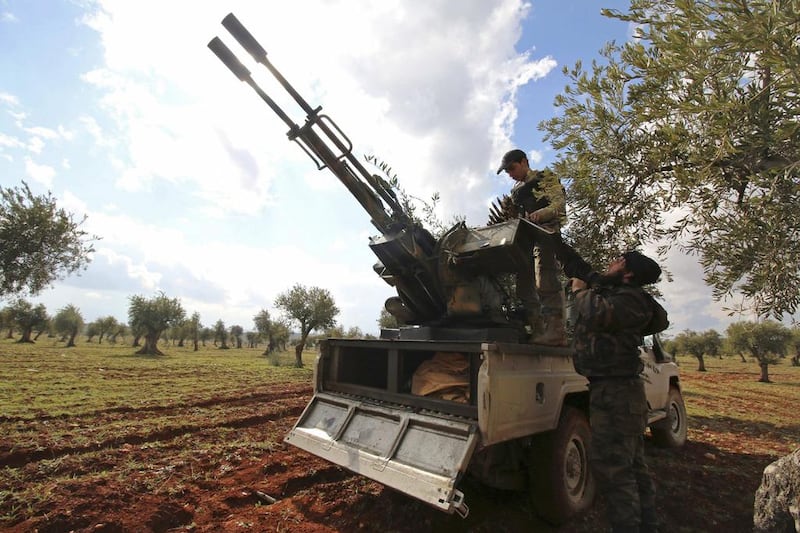AMMAN // Iran has expanded its role in the war against western and Gulf-backed opposition groups on Syria’s southern front, strengthening its forces and taking direct command of military operations there.
Since January, thousands of fighters from Hizbollah, Iran, pro-Iranian Iraqi militias, and some Afghans — all Shiites — have been dispatched to face advancing rebel units in southern Syria, according to various rebel sources.
Assad Zoubi, a defected Syrian air force general based in Jordan’s capital Amman who is affiliated with Western-backed rebel groups, said they believed 6,000 Hizbollah and Iranian fighters had been dispatched to the area in the last two months — equivalent to an entire army division.
The information could not be independently confirmed but well-placed rebels said Iran's growing presence in the south had alarmed the Military Operations Command (MOC) in Amman, the secretive centre staffed by officers from the armed forces of Western and Gulf States, which provides planning, logistics, funding and weapons to moderate rebel groups seeking to overthrow Syrian president Bashar Al Assad.
Last month, Jordan sent armoured units up to its northern frontier to bolster security there.
“We continue to strengthen our borders,” Mohammad Al Momani, Jordan’s minister of state in charge of media affairs, said. “It’s the sovereign right of any country to move troops as necessary.”
Iran has played a central role in propping up the Assad dynasty, providing armaments, personnel and military expertise to shore up the Syrian regime’s defences.
Hizbollah, an Iranian supported militant group, has sent thousands of fighters from Lebanon and helped win important victories for Mr Al Assad in central and northern Syria.
The UN estimates more than 220,000 people have been killed in the war that began in 2011 as a peaceful uprising, which was brutally suppressed by the regime, and morphed into a proxy conflict pitting Iran, Russia, and the Syrian regime against the US, Gulf states, and Syrian rebels.
Until two months ago, Iran’s principle role in the southern zone was more limited. Hizbollah fighters were present, but in much smaller numbers, while Tehran had sent in military advisers and experts in battlefield tactics such as sniping, rebels said.
Websites supporting Mr Al Assad have boasted about the presence of Hizbollah and Iranian units. One site, a Facebook group titled "The National Defence Centre — Deraa" referenced a direct role in the management of regime operations in the south for Major General Qasim Suleimani, head of Tehran's elite Qud's forces and one of the most powerful people in the Middle East.
“Two months ago Iran began leading the operations [in southern Syria],” said a rebel commander. “Their main target is to reclaim the areas that the rebels seized which present a crucial point between the outskirts of Damascus, Quneitra and Deraa.”
[ Syria’s southern battleground – map ]
Syrian regime fighters, captured by advancing rebels, as well as informants from within the Assad regime had confirmed Iran’s assumption of command, he said.
The decision that Tehran should play a more aggressive, front-line role in the south came after a series of rebel advances including their seizure of Tal Al Hara, an electronic listening station used by the Syrian regime to monitor rebel communications and to watch Israel and the Golan Heights, Syrian territory under Israeli occupation since 1967.
Aided by the MOC, rebel units were gaining ground, working to open supply lines to their colleagues fighting in and around Damascus. They had also come close to severing supply routes to loyalist forces in Deraa city, potentially cutting them off from ground resupply. Rebels control 65 per cent of Deraa province and large parts of the city, but regime units have stubbornly dug in there.
“After its losses in the southern front, the regime has lost troops and therefore is trying to compensate for that with [reinforcing] forces with mercenaries from Iran and Hizbollah,” said Ziad Hariri, deputy chief of staff for the rebel Southern Front alliance.
“When Hizbollah came, the rules of the game changed. The Golan has become the new battle field for Hizbollah,” he said. “ But if we control the Golan, we will pull the rug under the regime’s feet.”
The southern battlefield has been less fragmented than in the north and east of Syria, with a more coherent if still far from united, rebel force. ISIL, which controls large swathes of eastern Syria and western Iraq, has yet to gain a foothold there. The Al Qaeda affiliated Jabhat Al Nusra is a major force in the southern zone, however, and has been prominent in the rebel advances.
Rebel units are still attempting to inch towards the Syrian capital, and to cut off regime troops in Deraa but they are now doing so against a better managed, more effective and more powerful regime force, including several army divisions. Air strikes and artillery have been used in fierce battles around the towns of Deir Al Adas, Kanaker, Namer and Sheikh Miskeen.
Iranian command has brought with it new tactics, rebels said, including hit and run squads riding motorcycles and equipped with night vision goggles and machine guns or rocket-propelled grenade launcher, which have harried rebel controlled areas.
“They attack from lots of different directions, all at once, like ants,” said a rebel commander, referring to a recent successful regime attack on Deir Al Adas. “The regime is now well organised,” he added.
foreign.desk@thenational.ae
*Phil Sands contributed from Boston, USA





